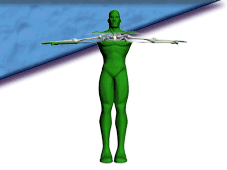Cervicogenic HEADBANGER Headache
 Why is it that so many patients come into my practice complaining of chronic, recurrent headaches,
none of which has even evaluated for the possibility of the patient having headaches of neck joint and
muscle origin? I think that part of this answer lies in the fact that this type of headache is somewhat
difficult to diagnose by way of standard neurologic testing. Dr. Ottar Sjaastad coined the term
"cervicogenic headache" in 1983 by recognizing and identifying a common subgroup of headache
patients with the addition of neck pain or dysfunction. Since it was first discovered in neck trauma
patients I am just going to call it the "Headbanger". Since that time it has been noted to be as common
in patients who have had no history of head or neck trauma. Traditionally, this type of headache has
not been well understood. In order to improve this situation I would like to offer an evidence-based
review of the literature on the Headbanger, CGH (cervicogenic headache) in order to improve our
understanding and consequently, our treatment of this common and vexing condition.
Why is it that so many patients come into my practice complaining of chronic, recurrent headaches,
none of which has even evaluated for the possibility of the patient having headaches of neck joint and
muscle origin? I think that part of this answer lies in the fact that this type of headache is somewhat
difficult to diagnose by way of standard neurologic testing. Dr. Ottar Sjaastad coined the term
"cervicogenic headache" in 1983 by recognizing and identifying a common subgroup of headache
patients with the addition of neck pain or dysfunction. Since it was first discovered in neck trauma
patients I am just going to call it the "Headbanger". Since that time it has been noted to be as common
in patients who have had no history of head or neck trauma. Traditionally, this type of headache has
not been well understood. In order to improve this situation I would like to offer an evidence-based
review of the literature on the Headbanger, CGH (cervicogenic headache) in order to improve our
understanding and consequently, our treatment of this common and vexing condition.First, we can say that the research does a good job of disproving some of the common misconceptions about chronic headaches. One of these myths is that the headache is always of a single origin. The International Headache Society published their International Classification of Headache Disorders, which identifies 14 different types of headaches. Since Headbanger (cervicogenic headaches) affect women four times more than men we must consider menstrual and hormonal shifts as a contributor to the headaches. Menstrual related headaches are usually a migraine type but, according to the research, may be cervicogenic Headbangers, also. The work of Dr. Bogduk suggests that the following contribute to the CGH: upper neck (C1, 2, and 3) facet joints, upper neck muscles, uppermost neck disc, vertebral and internal carotid arteries, back and base of skull tissue. Dr. Chua recently reported that patients with neck dysfunction and headache had more sensory testing impairments (mainly of the trigeminal, or "head pain" nerve) compared to patients with neck dysfunction and no headache. To further illustrate the fact that Headbangers can be part of a "bigger" headache (multiple sources), migraine and tension- type headaches often also include neck pain. This is not to mention that true migraine headaches are considered unilateral, predominantly on one side of the head, just like Headbanger cervicogenic headaches. Much of the confusion over the source of chronic headaches can be explained by the theory that they are caused by multiple sources acting together, with some factors more predominant on occasion and others more predominant on other occasions.
Cervicogenic Headbanger headaches are unilateral in origin (hemicranias), starting from one side of the back of the head and neck, but usually disseminate so rapidly over the head that the patient is often not aware of there being a dominant side of origin. CGH can be aggravated by certain head positions and occupations. Because these effects are often delayed by hours the patient may have a difficult time with this cause and effect. A large majority of these patients develop headaches after specific neck movements or sustained postures (for example, looking up for a prolonged period or watching a movie). Certain sleep postures can also cause the Headbanger to start up. While the doctor can incite the headaches by palpating the trigger points at the base of the skull or by placing the head and neck in a sustained aggravating position, he sees a normal MRI.
Another myth is that cervicogenic headache is rare and "incurable". Headbangers were recently determined to affect 2.2% of the population and recurring headaches in general to affect 47%. This does not take into account that Headbangers may, in fact, be a component of other types of headaches, raising this total to as much as 47% of the population. In time we should see a more factual number somewhere between 2.2 and 47%. Once properly diagnosed the cure rate for cervicogenic headaches is high and the improvement/control rate even higher. The patient is given therapy and manipulation specific for the upper neck problem and, just as important, exercises that have tested and proven effective for the treatment and prevention of the Headbanger.
Return to the Articles Page
Return to the Where's Your Pain? Page



